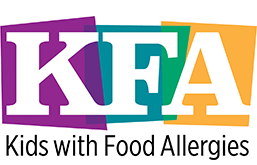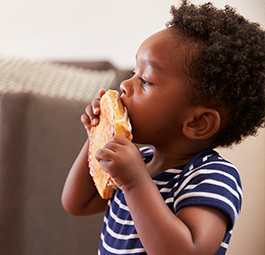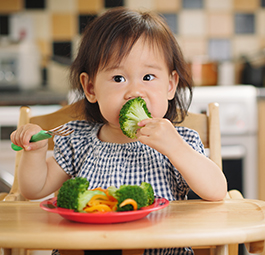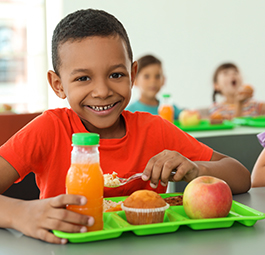This content has been archived. It may no longer be relevant
Newly Diagnosed

Living With Food Allergies Is Not Easy!
Kids With Food Allergies (KFA) is here to help keep your family safe and healthy. KFA is part of the nation’s oldest and largest asthma and allergy charity, the Asthma and Allergy Foundation of America (AAFA).
New Diagnosis of Food Allergy
Overwhelmed? Lost? Alone? We are here to help as you begin your food allergy journey. Did your child receive a diagnosis following a severe allergic reaction? Or was your child finally diagnosed after months of unexplainable tummy problems, rashes, or formula switches? Either way, we know that the adjustment to living with food allergies can be overwhelming.
Our website offers you a rich and trusted source for information you need to learn how to read labels and to serve safe foods. In addition, you can learn how to prevent allergic reactions and treat a reaction should one occur. Our award-winning online support community and our national network of local support groups will help you connect with other families who are managing food allergies so you don’t feel alone.
Children With Food Allergies: What Parents Need to Know

One in 13 kids has a food allergy.
A food allergy occurs when the body’s immune system sees a certain food as harmful and reacts by causing one or more symptoms. This is known as an allergic reaction. Foods that cause allergic reactions are called allergens. Allergic reactions usually occur after your child eats a food they are allergic to.
- Eggs
- Milk
- Peanuts
- Tree nuts, such as walnuts
- Sesame
- Soy
- Wheat
- Shellfish, such as shrimp, crab, and lobster
- Fish
The most common food allergies in infants and children are eggs, milk, peanuts, tree nuts, soy, and wheat.
Children may outgrown some allergies (egg, milk, and soy) but may be less likely to outgrow others (peanut, tree nuts, fish, and shellfish).

Be Aware of Food Allergy Symptoms
The type of symptoms and their severity may vary from one reaction to the next. Sometimes allergy symptoms are mild. Other times, symptoms can be severe and result in a serious allergic reaction called anaphylaxis [anna-fih-LACK-sis]. Anaphylaxis is an allergic emergency that can cause serious, potentially life-threatening complications. An allergic reaction to a food can involve one or more symptoms of the skin, mouth, eyes, lungs, heart, gut, and brain. Some symptoms of an allergic reaction include:
- Skin rashes and itching and hives
- Swelling of the lips, tongue, or throat
- Shortness of breath, trouble breathing, wheezing (whistling
sound during breathing) - Dizziness and/or fainting
- Stomach pain, vomiting, and diarrhea
- Feeling like something awful is about to happen
Your child’s doctor will give you a complete list of possible symptoms. This list of symptoms is also on your written Anaphylaxis Action Plan.
Be Prepared for Anaphylaxis
Work with your child’s health care team on how to recognize the signs and symptoms of anaphylaxis and how to treat it. Here’s how you can be prepared:
- Have a written Anaphylaxis Action Plan, also called a food allergy emergency care plan. Your child’s doctor will give you this step-by-step plan on what to do in an emergency.
- Learn how to give your child epinephrine. It’s the only treatment that will stop anaphylaxis.
- Epinephrine is safe and comes in an easy-to-use device called an auto-injector. It injects a single dose of medicine when you press it against your child’s outer thigh. Your child’s health care team will show you how to use it.
- Teach people who spend time with your child how to use the auto-injector.
- Consider having your child wear or carry a medical alert ID to let other people know of the allergy.
- Follow the steps in your child’s Anaphylaxis Action Plan to give your child epinephrine right away. This can save your child’s life.
- After giving epinephrine, always call 911 or a local ambulance service. Tell them that your child is having a serious allergic reaction and may need more epinephrine.
- Your child needs to be taken to a hospital by ambulance. Medical staff will watch your child closely for further reactions and treat them if needed.
Take Steps to Avoid Allergic Reactions
The only way to avoid an allergic reaction is for your child to stay away from foods that have caused symptoms. Here are some steps you can take:
- Learn how to read food labels for ingredients your child is allergic to. Read the label every time you buy a product, even if you’ve used that product before. Food ingredients in any given product may change.
- Ask about ingredients in foods that other people make for your child.
- Avoid passing allergens to foods that are safe for your child to eat by washing your hands and your child’s hands with soap and water before handling food. Prepare and serve foods with clean utensils and other kitchen items and on clean surfaces.
- Educate family, friends, and other people who will be with your child about your child’s allergies. Be sure to tell your child’s school and anyone responsible for your child about their food allergies.
- Teach your child how to manage their food allergies. You can start teaching your child even at a young age. When old enough, teach your child to read labels. Also teach your child how and when to use an epinephrine auto-injector and to tell an adult if they are having an allergic reaction.
- After the diagnosis, focus on what safe foods your child can have, rather than what they can’t have. Start with plain foods with simple ingredients. From there you can look for new recipes that use safe ingredients.
Medical review January 2014.
Frequently Asked Questions
KFA offers a trusted source for learning how to live safely with food allergies. We want you to have the information and confidence you need to manage food allergies. We will also give you tools to teach your child to self-manage their food allergies independently. When dealing with a diagnosis of food allergy, many parents and caregivers have questions about how to keep their child safe. KFA will help you answer those questions. Everything we do, from our webinars to our printable handouts, is carefully reviewed by our medical advisory team. Best of all: our resources are free.
Closed
Recipe Substitutions for Food Allergens
How Do You Substitute Eggs?
There are many ways to replace eggs in recipes. In baking, you can use pureed or mashed fruits or root vegetables, chia seeds, or a combination of water-oil-baking-powder. This guide will help you learn how to replace eggs in your recipes so you can bake and cook egg-free.
How Do You Substitute Milk?
There are numerous alternative beverages made from other foods including soy, rice, almond and coconut. There are also milk-free margarines and cheeses. This guide will help you learn how to replace milk in your recipes so you can bake and cook milk-free.
Food Allergens
What Are the Most Common Food Allergies?
Eight foods are reported to cause most food allergic reactions in the United States: milk, egg, peanut, tree nuts, soy, wheat, fish and crustacean shellfish.
What Are the Hidden Names for Allergens?
It is important to know how to read labels to identify common food allergens. Refer to KFA’s avoidance lists to help you read a label to find hidden names for allergens.
Diagnosing Food Allergy
What Do You Need to Know About Food Allergy Testing?
What is the difference between a blood test and a skin prick test? What does a positive or negative test result mean?
Other Popular Food Allergy Topics
What are the Symptoms and Treatment for Anaphylaxis?
Mild and severe allergy symptoms can lead to a serious allergic reaction called anaphylaxis. Anaphylaxis usually involves more than one part of the body and can get worse fast. Learn more about the symptoms and treatment for anaphylaxis.
What is Food Protein-Induced Enterocolitis Syndrome (FPIES)?
FPIES is another type of food allergy. It most often affects young infants and can cause severe vomiting and dehydration.
How Do You Choose Formula for an Infant with a Food Allergy?
If breastfeeding isn’t an option, what formula should you introduce to your allergic baby? Here is a list of different types of formula available to you.
Where Do You Begin to Find Safe Foods at the Grocery Store?
Successful grocery shopping while managing food allergies takes time. Get to know these steps for a faster trip: Know the how to read labels for food allergens. Always check the ingredient statement for allergen warnings. Learn the allergy labeling loopholes and understand the risks of cross-contamination (also known as cross contact).
Is There Anything You Can Do to Prevent Food Allergies in Babies and Children?
Learn more about the latest recommendations for pregnant or nursing moms and babies at risk for developing food allergies.
Medical Review: June 2022 by John James, MD
References
[1] Healthy People 2020










